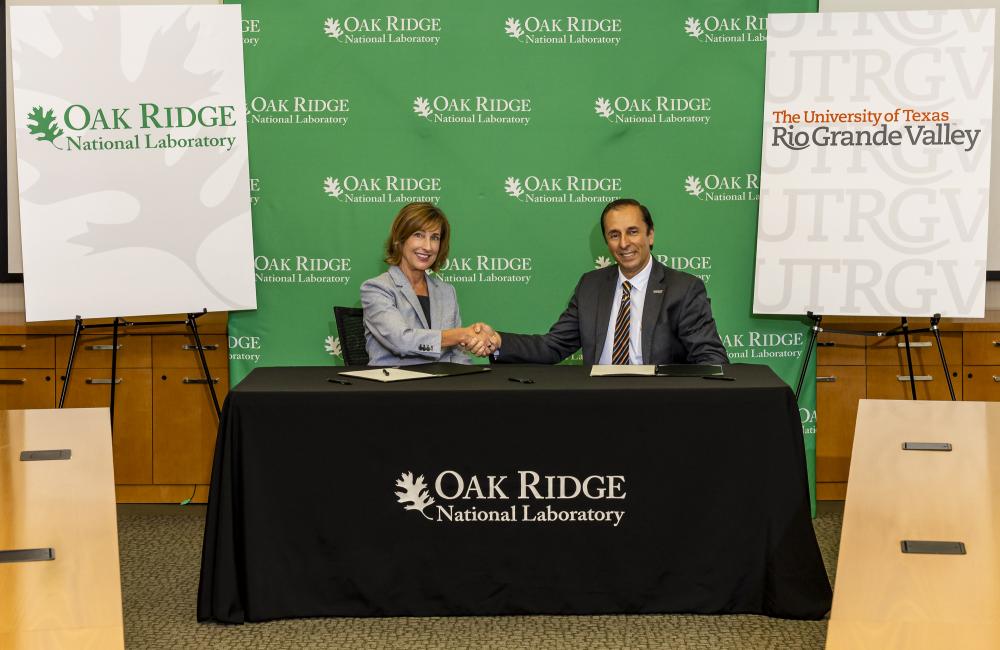Susan Hubbard, ORNL’s deputy for science and technology and Can (John) Saygin, senior vice president for research and dean of the graduate college at UTRGV, sign a memorandum of understanding to strengthen research cooperation and establish a collaborative program for undergraduate research and education. Credit: Carlos Jones/ORNL, U.S. Dept. of Energy
The Department of Energy’s Oak Ridge National Laboratory and the University of Texas Rio Grande Valley, known as UTRGV, have signed a memorandum of understanding to strengthen research cooperation and establish a collaborative program for undergraduate research and education, further cementing relationships and collaboration between the lab and minority-serving institutions. This partnership builds a pathway for students to pursue science, technology, engineering and mathematics, or STEM, careers through DOE by complementing UTRGV’s academic programs.
“It is a privilege to expose students to the national laboratory system and the Department of Energy mission, and to help to create a STEM pipeline that is important for ORNL and our nation,” said Susan Hubbard ORNL’s deputy for science and technology. “In partnership with UTRGV, we are committed to attracting and nurturing diverse students who are driven to find innovative and effective solutions to the complex challenges we face today and in the future.”
ORNL and UTRGV aim to prepare undergraduate students in critical DOE mission areas including neutron scattering, national security research, renewable energy and materials, manufacturing, environmental sciences and computer sciences. This partnership will allow students access to world-class research staff and premier DOE Office of Science user facilities such as the Oak Ridge Leadership Computing Facility — home of Frontier, the world’s fastest supercomputer — the Spallation Neutron Source and the High Flux Isotope Reactor.
“This MOU will have a strong impact on our students and faculty through new research endeavors and educational programs. By engaging undergraduate students in materials science, computer science and national security research, we are not only enhancing their academic journey but also contributing to the advancement of these critical fields," said Can (John) Saygin, senior vice president for research and dean of the graduate college at UTRGV.
“Additionally, through this collaboration we aim to foster a culture of research excellence while providing our students with hands-on experiences, bridging the gap between theory and practice,” Saygin said.
Strengthening education and research collaboration between UTRGV and ORNL will introduce students to scientific research, career development and mentorship opportunities at DOE’s largest multidisciplinary national laboratory. The goal is to prepare students to become part of the future laboratory workforce while enhancing their education and providing new opportunities.
UTRGV is a public research university and a Hispanic-serving institution located in South Texas, with two main campuses in Brownsville and Edinburg. The university strives to empower students to be the next generation of leaders by collaboratively addressing cultural, scientific, technological and socioeconomic issues of the region and the world through innovation and research. With one of the largest Hispanic student bodies in the country, UTRGV is committed to student success, access and engagement.
Together, ORNL and UTGRV want to increase participation and retention of underrepresented minority students in STEM programs and increase student access to ORNL’s research and mentoring programs.
UT-Battelle manages ORNL for Department of Energy’s Office of Science, the single largest supporter of basic research in the physical sciences in the United States. The Office of Science is working to address some of the most pressing challenges of our time. For more information, please visit energy.gov/science. – Gabriela Vara



